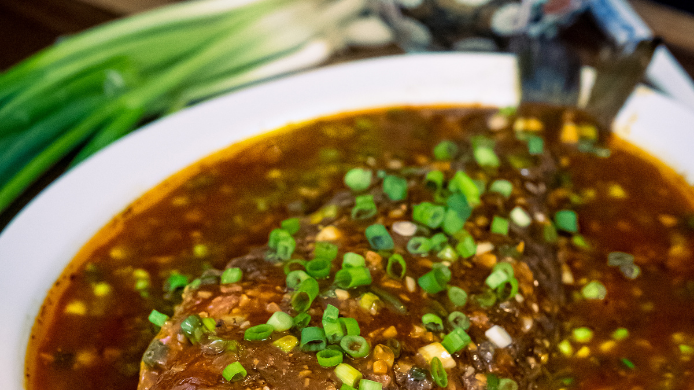Today, we are making Dou Ban Yu (豆瓣鱼). Yu (鱼) is fish. Dou Ban (豆瓣) is referring the key ingredients Sichuan Dou Ban Jiang, also known as fermented board bean paste with chili oil. The fish is pan-fried until golden brown then simmered in a super flavorful sauce. It is just incredibly delicious. So, let’s get started.

I am using a sea bream today. You can also use other types of white fish. This guy is about 1.3 pounds, and it is already halfway prepared. They scaled the fish, sliced down the belly, removed the guts, gills, fins, and rinsed everything out. I don’t really need to do anything besides to make a few open cuts on each side of the fillet; that will allow the flavor to infuse into the fish meat.

Rub the fish with some crushed scallions, ginger, and a drizzle of Chinese cooking wine. Set the fish aside at room temperature for 15 minutes.

While waiting, we can make the sauce. As I mentioned before, Dou Ban Jiang is the key ingredient, so the quality of this paste does affect the final result. There are many brands out there, and I recommend this Juan Cheng Pai. It is a local and time-honored brand in Sichuan. (I am not sponsored, but you can buy it by clicking here…)

Whenever you use Dou Ban Jiang, you always want to either pound it or blend it to even out the flavor because those board beans pieces are quite firm. So, add 3.5 tbsp of the Sichuan Dou Ban Jiang to the blender cup. Follow up with 2-3 pieces of pickled chilies. This will add some depth of flavor to the dish. If you don’t have it, you can use 1 tbsp of sriracha or sambal chili sauce instead. Continue by adding 2 tbsp of Chinese cooking wine.
Blend everything into a puree. An optional step, let it go through a sieve to get rid of those stubborn seeds. I mean, seeds are edible, but they are annoying that they can get in between your teeth. Set the sauce aside.

One of the reasons that I love this dish is that it is loaded with tons of garlic. 10 cloves – remove the root and crush them one by one. Dice them finely.
1 inch of ginger, crush and finely mince it.
4 scallions- remove the root, dice them as well.
Set everything aside.

Next, we will pan-fry the fish. This is a tricky endeavor because fish meat will stick badly onto the wok if you don’t cook it right. So today, I am going to show you a few tricks of how to pan-fried the fish without sticking to the Pan.
The first thing you want to do is to bring the fish to room temperature. That is why I let it sit at room temperature while marinating. You don’t want it to be too cold, otherwise, it will drop down the wok’s temperature too much. That will cause the fish to stick to the wok.
Remove all the aromatics now because we don’t need them anymore. The second key factor is to make sure your fish skin is dry. The moisture is also one of the reasons why meat sticks to the wok. So, do your best to pat it dry with paper towels.

Turn the heat to high and heat your wok to smoking hot. This is the most important step. Let me say it this way; if your meat is wet and cold, you can still get a good non-stick result cooking it in a super-hot wok. But if the wok is not hot enough, you will end up with a sticky mess no matter what you do. Now I am going to add the oil and toss it around.
Another trick I will share is to sprinkle in 1/2 tsp of coarse sea salt into the oil. Swirl it around. Then place in your fish. The salt acts as a barrier between the fish and the wok, so it will stick less. This will not make your fish salty because salt doesn’t melt in oil.

Once the middle part is fried, you can tilt the wok and move the heat source to the head and the tail so the whole fish cooks evenly. My wok is big enough to fry this whole fish. If your cookware is small, you can definitely cut the fish in half and fry each part separately.

It will take a few minutes on each side. You just go by the color. Once it is golden brown, you can flip it and fry the other side. Another mistake that people often make is to constantly slip the spatula under the filet to check whether the skin is sticking or not. Do not do that unless you can see some brown color on the edge. As I mentioned before, pan-frying fish is very tricky. The meat will stick to the cookware, even if you have done every step right. The secret is that it will release itself from the work surface when the bottom is properly seared. So, you just have to trust it. Give it enough time for it to be ready. If you move it too early, you are breaking the skin, which causes the juice to leak out; that decreases the temperature of the wok and makes the fish stick even worse. It is just a frustrating vicious cycle.

I fry the fish for 1.5 minutes on each side over high heat. It looks beautifully cooked on the outside, but the inside is still raw. Right now it is at 91 fF. Fish cooks at 145 F. So this is perfect because later on, we will simmer it with the sauce. If the fish is fully cooked right now, it will be overcooked later.

Oh, let me show you the salt crystals left in the oil. That is what I was talking about. The salt did not season the fish at all. You can continue to use this leftover oil to cook the sauce, but because it has the salt in it, you will have to adjust the flavor of the sauce. The easiest thing to do is to discard everything and start with new cooking oil.

Turn the heat to low. Add 3 tbsp of oil. Pour in the sauce. Stir it on low heat for a few minutes. Then add in the garlic and ginger. Keep cooking for a couple of minutes or until they are fragrant. Pour in 1.5 cups of water.

Bring this to a simmer. Give it a taste before seasoning it because every brand of Dou Ban Jiang is slightly different. Mine needs 2 tsp of sugar, 2 tsp of soy sauce, and 1.5 tbsp of Chinese black vinegar. Depends on the brand that you are using, you might need to adjust the measurement a little bit.

Turn the heat to medium low. Place the fish back in the wok. We will simmer each side for a couple of minutes. During this time, it is important to spoon the sauce over the fish constantly. Then flip it over and do the same thing.

Turn off the heat. Carefully take the fish out. Place it on a plate.

Quickly mix 1 tbsp of cornstarch with 1.5 tbsp of water. Pour it into the sauce. Turn the heat back on low. Stir to mix. Once the sauce is thickened up, toss in the diced scallion.
Pour this sauce all over the fish, and you are done.

The fish is perfectly cooked. The outside layer that we browned absorbs lots of flavor from the sauce, so it is super savory on the outside while the inside stays tender, juicy and sweet. The sauce goes crazily good over white rice. I hope you can give this a try soon. Enjoy!














































































